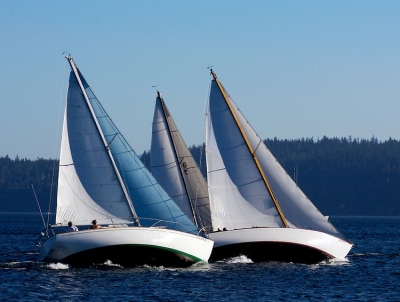
Seeing a sailboat travel downwind makes sense even to landlubbers. The wind pushes the sails and the boat moves forward. But seeing a sailboat travel upwind is baffling – especially once you learn that the wind is “pulling” the boat. How is that possible? Simple physics!
It might not look like it, but a sailboat’s sails – especially modern triangular sails – are really just giant wings. Like an airplane wing, each sail is shaped so that air moves faster over one side than it does over the other. This creates lift on the surface of the sail facing the wind, which “pulls” the sail (and the boat to which it’s attached) forward at an angle against the wind even as the wind pushes the boat away in the in the downwind direction. This downwind slippage – known as leeway – is counteracted by a wing that you can’t see: a heavy fin called a keel that runs down the center of the boat underwater. The keel’s weight and shape counteract the force of the wind striking the sail above the water, keeping the boat from sliding downwind or being pushed over by the force of the wind (which is why you often see sailboats leaning over; the weight of the keel is keeping the boat from capsizing).
By controlling the angle of the sails, a captain can chart a course against the wind. Sailing directly into the wind is impossible, however, because the captain always needs to keep the wind at the correct angle to pull the sails forward. By sailing a series of zigzags – or “tacking” – across the wind, the captain can chart course to destinations that lie completely upwind.
Picture Credit : Google
